The Savage 1911 finally arrived at my FFL after waiting quite a few months. Some of the big guys got theirs first and that’s ok. I have mine now, and I have given the pistol a good workout. Savage may not be best known for their handguns, but I have to say, this is a credible addition to the 1911 world, and there are certainly plenty of 1911 types to compare this piece to. It doesn’t come off badly at all and seems worth the money. There isn’t anything you cannot get anywhere else, but for Savage fans now you have a good handgun to go along with your Savage Scout Rifle or Impulse straight-pull bolt-action.
Savage also introduced a compact 9mm version of the old Honor Guard handgun. I tested several Honor Guard pistols with good results. But this is a 1911!
I have been a Savage fan for many years and own a number of good quality Savage rifles and shotguns. Some are utilitarian and quite a few are very nice firearms comparable to many other great guns on the market.
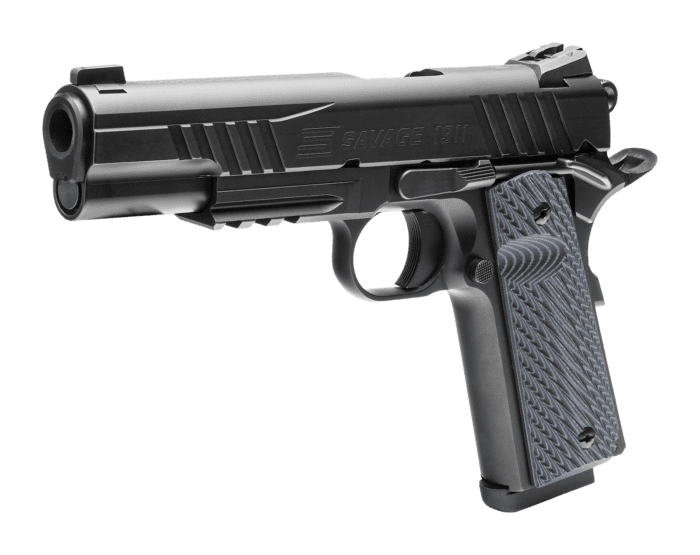
The Savage 1911 is a government-model size that comes in a steel frame with a 5-inch barrel, putting the whole package right at the 40-ounce mark unloaded. The initial run includes pistols in 9mm and .45 ACP.
My version is a black nitride finished .45 ACP. Other than my black Melonite model and the stainless-steel pistol, a two-tone pistol should soon be available. Both slick dust cover and picatinny rail guns are offered. My example is a rail gun. The pistol is feature rich as the media types tell us, and in this case they are correct.
First Impressions
The barrel bushing is snug but not so tight that a busing tool is needed to adjust it. The recoil system consists of a standard recoil plug without a full-length guide rod. When using heavy loads in a pin gun, maybe you need a full-length guide rod. In this case, the system is uncomplicated. The seams are all well fitted.
As I rack the slide, the locking lugs slide out of battery smoothly. The barrel features a well-polished feed ramp. The slide boasts a nicely tooled indentation between the sights. There is some lateral play in the slide but only a little. The slide treatment is interesting, however. When SIG went with a unique slide, they also caused holster makers to design holsters to fit this SIG type slide. The sights on my Savage are a Novak Lo Mount design. They remain the standard by which all combat sights are compared and feature one of my favorite configurations. The front sight is a tritium post surrounded by a glowing green roundel. The rear sight is adjustable. To adjust windage unscrew the set screw and bump the sight. There are notches to help calibrate windage. I almost did not notice the sight is adjustable for elevation by a small set screw. A tritium bar rides in the rear sight making for the Bar Dot sight picture. I favor this sight picture over the three-dot pattern, but I suppose I am in the minority. The front and rear cocking serrations are well done.
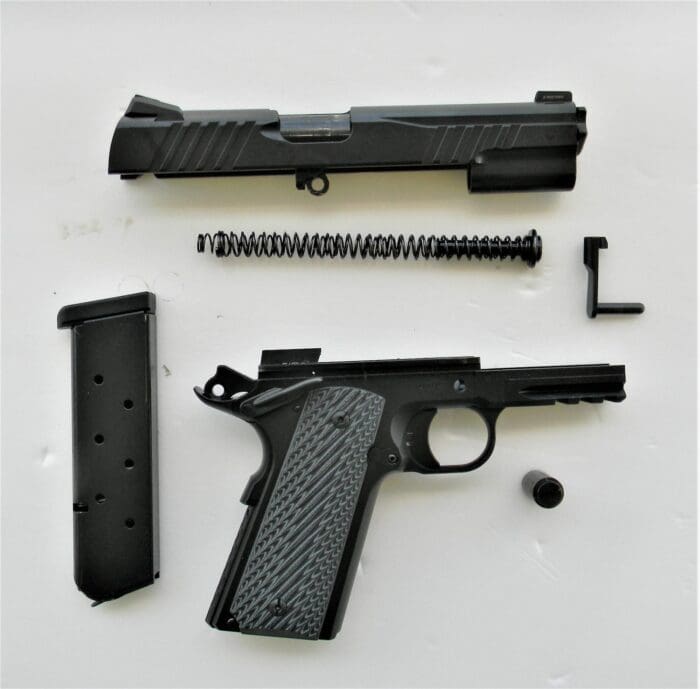
The hammer is a roundel type and is easily manipulated. The safety is an ambidextrous type, and while it indents well, it is not as sharp as I would like. But it works well. The grip safety maintains its hold on the trigger until the beavertail type grip safety is depressed just past half of its travel. The V 10 grips are nicely checkered. As for the trigger, compression is smooth enough but heavier than expected at 6 pounds even. This didn’t keep me from turning in good firing results, however.
The pistol came supplied with two eight-round magazines. I found one of them was difficult to load to full capacity, but that could simply be because it is new. Giving the gun one last look before taking it to the range, I noticed the barrel crown is nice but not necessarily the 45-degree cut of a custom barrel I’m used to seeing, but that said, all of the parts fit together quit well.
I lubricated the pistol well beginning with the muzzle near the bushing and then lubricating the barrel hood and cocking block as well as letting oil run into the slide rails. That is what keeps a 1911 running along with good ammunition and good quality magazines. It was time for the range.
Shooting the Savage
I first tested the gun primarily using Black Hills Ammunition. I used their clean-burning 230 grain FMJ loads for most runs, firing combat-style at 5, 7 and 10 yards. The pistol handled quite well.
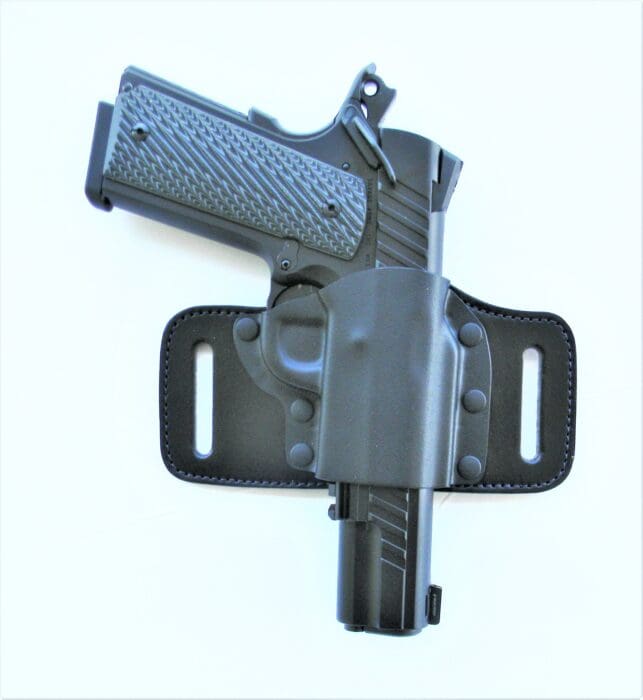
The trigger reset is at least as important as the smoothness of the trigger and the Savage has a good reset. You don’t really need or want a target trigger for combat shooting and this firing session proved just that.
Firing of the gun has gone well, and I really like the pistol. My only complaint is one of the Savage magazines balked and short cycled on me, and I don’t feel like they were break-in short cycles. I think the one mag glitched. This isn’t unheard of but neither was it a welcome discovery.
In addition to the Savage mags, I had Cobra, Wilson Combat and my carry Springfield along with its mags, so I was not short on magazines. All of them locked in and fed well. With regards to magazines, I find Wilson Combat, D&L Sports and Cobra Mags are all a great investment in reliability no matter what 1911 you are shooting. MecGar is also a good magazine that I have used extensively in my shooting.
To date, after three range sessions, I have run at least 430 rounds of ammunition through the gun, and there have been no malfunctions once I ditched the one bad magazine. The other worked just fine.
The pistol was fired with the hot Black Hills Ammunition 135-grain Honey Badger and both 185- and 230-grain JHP loadings. The pistol shoots where it looks with the 230-grain loads so I left the sights right where they were. The Honey Badger shoots low by about 3 inches at 25 yards, but loads aren’t going to shoot the same as others so if I was going to go to shooting that more regularly from the gun, I’d make an adjustment.
Recoil seemed slightly lower than most Government Model 1911 handguns when I was shooting repeat shots. Perhaps it is courtesy of the springs. I fired the pistol for accuracy testing twice, once at 15 yards and later at 25 yards. I am a precision accuracy crank although it doesn’t necessarily apply to personal defense, where shots are practiced fast and at center of mass.
But then what about in a situation with an active shooter or a coyote attacking my goats? For these important reasons, I like to know exactly what the pistol—and I–can accomplish out to at least 25 yards. I used the MTM K Zone shooting rest because it is more stable than firing against a fence post. I also used the 230-grain FMJ loads for this test. While the 15-yard group was on top of itself and very tight, I was satisfied with the 2-inch groups from five shots fired at 25 yards. I was under no time limit; I braced the gun solidly and the results were good.
The 185-grain JHP was nearly as accurate. A handload using three 200-grain Hornady XTP bullets over enough Titegroup powder for 900 fps went into a 1.8-inch group for five shots. Ultimately, the pistol is clearly accurate enough for any chore we would put a handgun to. I like the Savage 1911 and looking at the price—between $1,350 and $1,500 depending on the configuration—compared to other 1911s out there, it’s a great deal. Check one out yourself and you will probably agree.
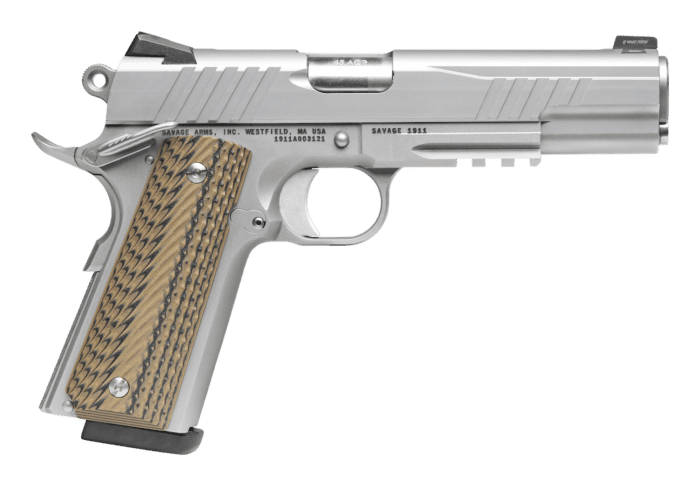
Range Notes
Reliability ******
Remarks: Other than one issue with one of the mags, everything else worked great.
Accuracy *****
Remarks: The accuracy of the Savage 1911 grouped shots with the solid accuracy I’d expect from a 1911.
Fit and Finish ****
Remarks: Good but some wear on the moving parts after the firing test.
Concealed carry ****
Remarks: A bit heavy, but as easily concealed as any 1911
Value ****
Remarks: 1911s are not cheap. Maybe the pistol will sell under MSRP in a few months.
Features
Action: Semi-Auto
Caliber: .45 ACP
Ejection Port: Right
Pistol Size: Government
Frame: forged stainless steel
Barrel: black with a Nitride finish, stainless steel construction
Receiver: stainless steel, black with Nitride finish
Slide: stainless steel, black with Nitride finish
Grips: G10 grips in black/gray color
Trigger: single action
Sights: Novak Tritium Mega Dot front, Novak Tritium Bar rear
Magazines: comes with 2 single stack mags, ambidextrous release controls
Safety: external grip and thumb safeties
Capacity: 8+1
Barrel Length: 5 in.
Overall Length: 8.45 in.
Weight: 2.54 lbs.
MSRP: $1,350-$1,500

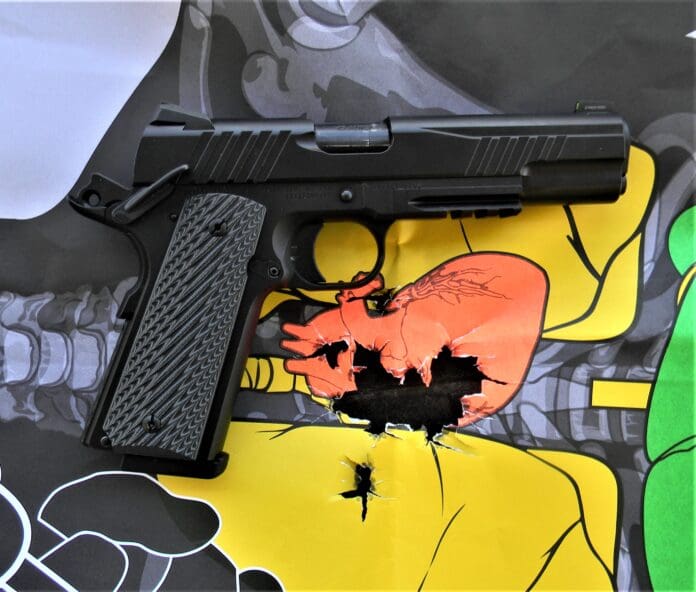



“Capacity: 8+1” Ugh, just make 1911s taking .45 Glock mags the new normal already.
The beauty of a 1911 is the thin grips & slide, if 1 wants more internal capacity then go with a 2011, Para or a G21, etc. The triggers on many 1911’s are unrivaled. i was a 1911/2011 factory production gunsmith in TX fer 3 solid years. Knowing how to tweak/tune/modify a 1911/2011 is ki
^^This. Slimmest full size gun one can run. Can go 9mm and do 10 + 1 as well. If slim is important to you then a full size 9mm 1911 is the easiest shooting carry piece one can use.
CC, I’ve carried a 1911 all my adult life. 25 years professonally. Never loaded it with anything other than a 7 round Wilson Combat magazine. I must own at least 50 of them. Magazine capacity is over rated.
agreed
True, dat.
If I need more than seven rounds, I probably should call in air support or I am in the Nakatomi Plaza building at a Christmas party.
Yippee-ki-yay
Not a word about Hawaii?
This site is rapidly deteriorating.
Do you actually think we aren’t going to run something on that?
After everyone else on Planet Earth, it would appear.
Its in a different time zone. Central – 4hr to the left
d. wesson/ cz and this seem pretty comparable, the sti stuff a little spendy. the ria i’ve seen were nice and cheap.
i’ve been asking ttag to review an ithaca 1911 for a decade.
and the only shottie reviewed was a replica trench.
What are you interested in seeing for Shotgun content?
i have new york 37s. i’d like travis to put a sandusky featherweight through its paces. i don’t think this sight has ever done a 28ga review of any make.
No front strap checkering.. no deal..
What he said especially for that price.
The price point is high. I wouldn’t pay that much for a 1911 from a company that has never made one before. You can buy a Sig STX for $1150 and that is a very nice, well refined 1911.
A remington R1 is $750. Even though I don’t care for them, Kimber’s are typically $1000 or less. So this 1911 is overpriced at best. In this day and age, it’s a race to see who can build the cheapest 1911, which so far as I know is the Tisas. Reviews on it are pretty much all positive, and seem to mirror this article’s review of the Savage.
At the end of the day, I wouldn’t pay that.
The tisas/sds imports are awesome fer the price, imo. i obtained 1, a cheaply priced 1911a1 5″ bbl (series 70 innards), that was purdy much all cerakoted blk, except the bbl. This included the whole hammer (hooks) & sear. A lil fine, ultra fine stoning of hammer hooks, dremel with flitz on other parts, tweak the mainspring, etc. Got as a ‘beater’, tho i really like it. Very well made. i put some old pachmayer signature series grips on it, that i had on hand from the 80’s. Think is prolly ~2.5# trigger pull weight, tho i have no gauge. No creep, clean break, accurate, no hammer follow. The sights do suck tho fer older eyes, lil gi style rear & narrow tenon front. i just put a lil fluorescent fingernail polish paint on the front
I shoot a stainless Tisas Duty SS45R, and like it quite a lot. I just Superized it, but haven’t had a chance to shoot it with the hotter ammo since sustaining a recent arm injury.
I got a Tisas basic GI model for my son for his birthday several months ago. Appears well made and the fitment of all parts is very good. If I recall correctly, it was right around four bills. Most importantly, he’s very happy with it.
Pictures of the slide and frame machining would tell me more than a basic it works review.
There needs to be a standard for any pistol that uses the term 1911 and that is, the pistol is within spec,any part of firearm different than Colt A1 specs should be noted.
There is nothing about this that entices me to buy. For that money, I’d be better off going to Springfield. Someone that’s been doing 1911’s for a while. But I want to see more of these in 10mm.
I don’t know who this guy is, but would love to keep reading his stories.
Still not sure what gun I would like to purchase. Any recommendations?
First gun for recreation
Rock Island is a good piece
Springfield 1911 a little better
To bet your life on the gun
Colt/ Dan Wesson. Springfield Loaded good buys
This is very simplistic but to the point
Little high MSRP for a bit of lateral slide play, probably a good 1911, got the Black finish, night sights and ejection port right however I would do a side by side with Girsan to see how much ammo and groceries the cost difference can buy.
yes, agree
The people at Savage must really believe their name justifies a premium this steep. Going to be a lot of sad faces when reality bites.
Agreed. At that price point, it has some nice features, but it really should have front strap checkering and a bit lighter trigger to be competitive with the rest of the market. Nice looking gun, though.
Here’s an irony: Savage was the company thT lost out to Browning’s design in the original Army pistol trials that made the 1911 what it is. Now, 100+ years later, they finally see the writing on the wall, I guess…
I kid, I kid. Looks like a nice gun. Kind of spendy for what it is.
I was interested until I saw the MSRP; Savage has always made great shooting (albeit ugly) rifles for great prices. I was hoping this would be in the $7-800 range.
actually spotting them in shops for 1195 or so. If that helps.
‘Remarks: 1911s are not cheap. Maybe the pistol will sell under MSRP in a few months.’
This one already sells under MSRP; https://www.ruger.com/products/sr1911Standard/specSheets/6792.html
I imagine it is a nice 1911, but I will never know because of the price. SA 1911 Garrison price point about $750, Ruger 1911 less than that. Thought I would never buy a Taurus 1911, I recently fingered one at my LGS. Surprised how smooth it was, maybe they upped their game.
Just another overpriced 1911. And I have several 1911”s, a SA and a Norinco. I reload and shoot them regularly.
MidwayUSA had on sale in Oct $884. Last 1911 I had/shot was issued in 1986/87 by Uncle Sugar. BIG difference.
I have a Remington R1 Enhanced, a Springfield Loaded, a Colt Defender and a Colt M45A1 MARSOC. Love them dearly. I found one of these Savage 1911’s for $900, and I think I might get it. Had a Rock Island Commander, but sold it because it was a nightmare to take apart.
Comments are closed.